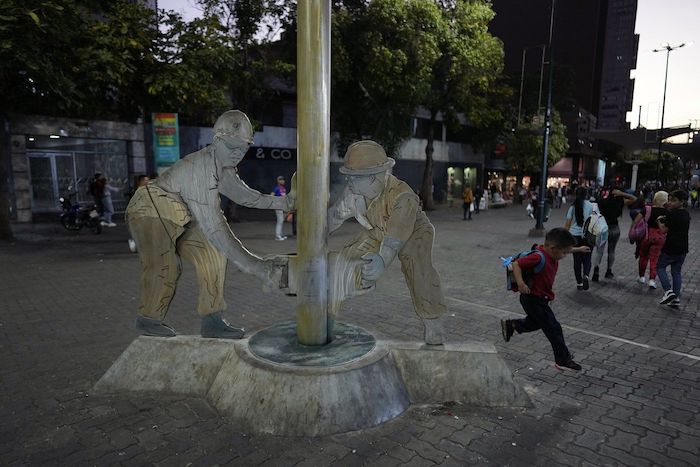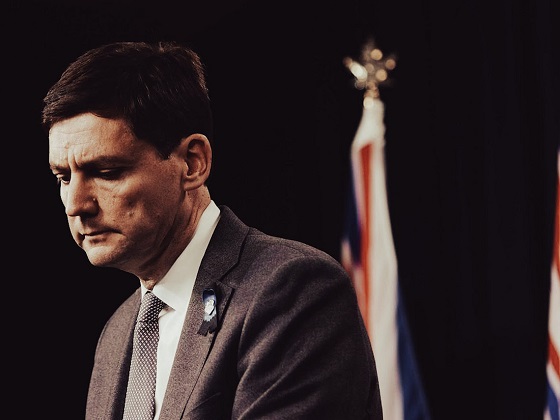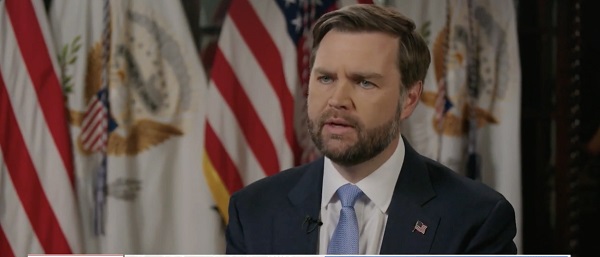Energy
Venezuela oil czar in surprise resignation amid graft probes

A boy jumps near the “Los Petroleros” sculpture that shows two men working on an oil drill of Petroleos de Venezuela, S.A, PDVSA, on the Sabana Grande boulevard, in Caracas, Venezuela, March 20, 2023. Venezuela’s oil czar, Tareck El Aissami announced his resignation on Twitter and pledged to help investigate any allegations involving PDVSA. (AP Photo/Ariana Cubillos)
By Regina Garcia Cano in Caracas
CARACAS, Venezuela (AP) — The man responsible for running Venezuela’s oil industry — the one that pays for virtually everything in the troubled country, from subsidized food to ridiculously cheap gas — has quit amid investigations into alleged corruption among officials in various parts of the government.
Tareck El Aissami’s announcement Monday was shocking on multiple counts. He was seen as a loyal ruling party member and considered a key figure in the government’s efforts to evade punishing international economic sanctions.
And he led the state oil company PDVSA in a Venezuelan business sector widely considered to be corrupt — in a country where embezzelment, bribery, money laundering and other wrongdoing are a lifestyle.
“Obviously, they are giving it the patina of an anti-corruption probe,” said Ryan Berg, director of the Americas program at the Center for Strategic and International Studies, a Washington-based think tank.
“Rule of law is not being advanced here,” Berg added. “This is really a chance for the regime to sideline someone that it felt for some reason was a danger to it in the moment and to continue perpetuating acts of corruption once particular individuals have been forced out of the political scene.”
Hours after El Aissami revealed his resignation on Twitter, President Nicolás Maduro called his government’s fight against corruption “bitter” and “painful.” He said he accepted the resignation “to facilitate all the investigations that should result in the establishment of the truth, the punishment of the culprits, and justice in all these cases.”
Venezuela’s National Anti-Corruption Police last week announced an investigation into unidentified public officials in the oil industry, the justice system and some local governments. Attorney General Tarek William Saab in a radio interview Monday said that at least a half dozen officials, including people affiliated with PDVSA, had been arrested, and he expected more to be detained.
Among those arrested is Joselit Ramirez, a cryptocurrency regulator who was indicted in the U.S. along with El Aissami on money laundering charges in 2020.
Corruption has long been rampant in Venezuela, which sits atop the world’s largest petroleum reserves. But officials are rarely held accountable — a major irritant to citizens, the majority of whom live on $1.90 a day, the international benchmark of extreme poverty.
“I assure you, even more so at this moment, when the country calls not only for justice but also for the strengthening of the institutions, we will apply the full weight of the law against these individuals,” Saab said.
Oil is Venezuela’s most important industry. A windfall of hundreds of billions in oil dollars thanks to record-high global prices allowed the late President Hugo Chávez to launch numerous initiatives, including state-run food markets, new public housing, free health clinics and education programs.
But a subsequent drop in prices and government mismanagement, first under Chávez’s government and then Maduro’s, ended the lavish spending. And so began a complex crisis that has pushed millions into poverty and driven more than 7 million Venezuela to migrate.
PDVSA’s mismanagement, and more recently economic sanctions imposed by the U.S., caused a steady production decline, going from the 3.5 million barrels a day when Chávez rose to power in 1999 to roughly 700,000 barrels a day last year.
David Smilde, a Tulane University professor who has conducted extensive research on Venezuela, said the moves by Maduro’s government are more than just an effort to clean its image.
“Arresting important figures and accepting the resignation of one of the most powerful ministers in a case that involves $3 billion does not improve your image,” he said. “It is probably because the missing money actually has an important impact on a government with serious budgetary problems.”
The Biden administration recently loosened some sanctions, even allowing oil giant Chevron for the first time in more than three years to resume production. Maduro’s government has been negotiating with its U.S.-backed political opponents primarily to get the sanctions lifted.
U.S. congressional researchers saw El Aissami as an impediment to Maduro’s goals.
“Should Al Aissami remain in that position, it could complicate efforts to lift oil sanctions,” a November report from the Congressional Research Center said.
The U.S. government designated El Aissami, a powerful Maduro ally, as a narcotics kingpin in 2017 in connection with activities in his previous positions as interior minister and a state governor. The Treasury Department alleged that “he oversaw or partially owned narcotics shipments of over 1,000 kilograms from Venezuela on multiple occasions, including those with the final destinations of Mexico and the United States.”
Under the government of Chávez, El Aissami headed the Ministry of Internal Affairs. He was appointed minister of oil in April 2020.
“El Aissami was a key player in the Maduro government’s sanctions evasion strategy. We’re talking about someone who knows where all the bodies are buried, so it will be key to watch where he ends up,” said Geoff Ramsey, a senior fellow at the Atlantic Council focused on Colombia and Venezuela. “If El Aissami ends up being implicated himself, it could have serious implications for the entire power structure.”
In September, Maduro’s government renewed wrongdoing accusations against another former oil minister, Rafael Ramírez, alleging he was involved in a multibillion-dollar embezzlement operation during the early 2010s that took advantage of a dual currency exchange system. Ramírez, who oversaw the OPEC nation’s oil industry for a decade, denied the accusations.
In 2016, Venezuela’s then opposition-led National Assembly said $11 billion went missing at PDVSA in the 2004-2014 period when Ramirez was in charge of the company. In 2015, the U.S. Treasury Department accused a bank in Andorra of laundering some $2 billion stolen from PDVSA.
2025 Federal Election
Canada Continues to Miss LNG Opportunities: Why the World Needs Our LNG – and We’re Not Ready

From EnergyNow.Ca
By Katarzyna (Kasha) Piquette, Founder and CEO, Canadian Energy Ventures
When Russia invaded Ukraine in 2022, Europe’s energy system was thrown into chaos. Much of the 150 billion cubic meters of Russian gas that once flowed through pipelines had to be replaced—fast. Europe turned to every alternative it could find: restarting coal and nuclear plants, accelerating wind and solar approvals, and most notably, launching a historic buildout of LNG import capacity.
Today, LNG terminals are built around the world. The ‘business case’ is solid. The ships are sailing. The demand is real. But where is Canada?
As of March 28, 2025, natural gas prices tell a story of extreme imbalance. While Europe and Asia are paying around $13 per million BTU, prices at Alberta’s AECO hub remain below $2.20 CAD per gigajoule—a fraction of global market levels. This is more than a pricing mismatch. It’s a signal that Canada, a country rich in natural gas and global goodwill, is failing to connect the dots between energy security abroad and economic opportunity at home.
Since 2022, Europe has added over 80 billion cubic meters of LNG import capacity, with another 80 billion planned by 2030. This infrastructure didn’t appear overnight. It came from urgency, unity, and massive investment. And while Europe was preparing to receive, Canada has yet to build at scale to supply.
We have the resource. We have the relationships. What we lack is the infrastructure.
Estimates suggest that $55 to $75 billion in investment is needed to scale Canadian LNG capacity to match our potential as a global supplier. That includes pipelines, liquefaction terminals, and export facilities on both coasts. These aren’t just economic assets—they’re tools of diplomacy, climate alignment, and Indigenous partnership. A portion of this investment can and should be met through public-private partnerships, leveraging government policy and capital alongside private sector innovation and capacity.
Meanwhile, Germany continues to grapple with the complexities of energy dependence. In January 2025, German authorities seized the Panama-flagged tanker Eventin, suspected of being part of Russia’s “shadow fleet” used to circumvent oil sanctions. The vessel, carrying approximately 100,000 tons of Russian crude oil valued at €40 million, was found adrift off the Baltic Sea island of Rügen and subsequently detained. This incident underscores the ongoing challenges Europe faces in enforcing energy sanctions and highlights the pressing need for reliable, alternative energy sources like Canadian LNG.
What is often left out of the broader energy conversation is the staggering environmental cost of the war itself. According to the Initiative on GHG Accounting of War, the war in Ukraine has produced over 230 million tonnes of CO₂ equivalent (MtCO₂e) since 2022—a volume comparable to the combined annual emissions of Austria, Hungary, the Czech Republic, and Slovakia. These emissions come from military operations, destruction of infrastructure, fires, and the energy used to rebuild and support displaced populations. Yet these emissions are largely absent from official climate accounting, exposing a major blind spot in how we track and mitigate global emissions.
This is not just about dollars and molecules. This is about vision. Canada has an opportunity to offer democratic, transparent, and lower-emission energy to a world in flux. Canadian LNG can displace coal in Asia, reduce reliance on authoritarian suppliers in Europe, and provide real returns to our provinces and Indigenous communities. There is also growing potential for strategic energy cooperation between Canada, Poland, and Ukraine—linking Canadian LNG supply with European infrastructure and Ukrainian resilience, creating a transatlantic corridor for secure and democratic energy flows.
Moreover, LNG presents Canada with a concrete path to diversify its trade relationships, reducing overdependence on the U.S. market by opening new, high-value markets in Europe and Asia. This kind of energy diplomacy would not only strengthen Canada’s strategic position globally but also generate fiscal capacity to invest in national priorities—including increased defense spending to meet our NATO commitments.
Let’s be clear: LNG is not the endgame. Significant resources are being dedicated to building out nuclear capacity—particularly through Small Modular Reactors (SMRs)—alongside the rapid expansion of renewables and energy storage. But in the near term, LNG remains a vital bridge, especially when it’s sourced from a country committed to environmental responsibility, human rights, and the rule of law.
We are standing at the edge of a global shift. If we don’t step up, others will step in. The infrastructure gap is closing—but not in our favor.
Canada holds the key. The world is knocking. It’s time we opened the door.

Sources:
- Natural Gas Prices by Region (March 28, 2025): Reuters
- European LNG Import Capacity Additions: European Commission
- German Seizure of Russian Shadow Fleet Tanker: Reuters
- War Emissions Estimate (230 MtCO₂e): Planetary Security Initiative
Energy
Trump Takes More Action To Get Government Out Of LNG’s Way


From the Daily Caller News Foundation
By David Blackmon
The Trump administration moved this week to eliminate another Biden-era artificial roadblock to energy infrastructure development which is both unneeded and counterproductive to U.S. energy security.
In April 2023, Biden’s Department of Energy, under the hyper-politicized leadership of Secretary Jennifer Granholm, implemented a new policy requiring LNG projects to begin exports within seven years of receiving federal approval. Granholm somewhat hilariously claimed the policy was aimed at ensuring timely development and aligning with climate goals by preventing indefinite delays in energy projects that could impact emissions targets.
This claim was rendered incredibly specious just 8 months later, when Granholm aligned with then-President Joe Biden’s “pause” in permitting for new LNG projects due to absurd fears such exports might actually create higher emissions than coal-fired power plants. The draft study that served as the basis for the pause was thoroughly debunked within a few months, yet Granholm and the White House steadfastly maintained their ruse for a full year until Donald Trump took office on Jan. 20 and reversed Biden’s order.
Certainly, any company involved in the development of a major LNG export project wants to proceed to first cargoes as expeditiously as possible. After all, the sooner a project starts generating revenues, the more rapid the payout becomes, and the higher the returns on investments. That’s the whole goal of entering this high-growth industry. Just as obviously, unforeseen delays in the development process can lead to big cost overruns that are the bane of any major infrastructure project.
On the other hand, these are highly complex, capital-intensive projects that are subject to all sorts of delay factors. As developers experienced in recent years, disruptions in supply chains caused by factors related to the COVID-19 pandemic resulted in major delays and cost overruns in projects in every facet of the economy.
Developers in the LNG industry have argued that this arbitrary timeline was too restrictive, citing these and other factors that can extend beyond seven years. Trump, responding to these concerns and his campaign promises to bolster American energy dominance, moved swiftly to eliminate this requirement. On Tuesday, Reuters reported that the U.S. was set to rescind this policy, freeing LNG projects from the rigid timeline and potentially accelerating their completion.
This policy reversal could signal a broader approach to infrastructure under Trump. The Infrastructure Investment and Jobs Act, enacted in 2021, allocated $1.2 trillion to rebuild roads, bridges, broadband and other critical systems, with funds intended to be awarded over five years, though some projects naturally extend beyond that due to construction timelines. The seven-year LNG deadline was a specific energy-related constraint, but Trump’s administration has shown a willingness to pause or redirect Biden-era infrastructure funding more generally. For instance, Trump’s Jan.20 executive order, “Unleashing American Energy,” directed agencies to halt disbursements under the IIJA and IRA pending a 90-day review, raising questions about whether similar time-bound restrictions across infrastructure sectors might also be loosened or eliminated.
Critics argue that scrapping deadlines risks stalling projects indefinitely, undermining the urgency Biden sought to instill in modernizing U.S. infrastructure. Supporters argue that developers already have every profit-motivated incentive to proceed as rapidly as possible and see the elimination of this restriction as a pragmatic adjustment, allowing flexibility for states and private entities to navigate permitting, labor shortages and supply chain issues—challenges that have persisted into 2025.
For example, the $294 billion in unawarded IIJA funds, including $87.2 billion in competitive grants, now fall under Trump’s purview, and his more energy-focused administration could prioritize projects aligned with his energy and economic goals over Biden’s climate and DEI-focused initiatives.
Ultimately, Trump’s decision to end the seven-year LNG deadline exemplifies his intent to reshape infrastructure policy by prioritizing speed, flexibility and industry needs. Whether this extends formally to all U.S. infrastructure projects remains unclear, but seems likely given the Trump White House’s stated objectives and priorities.
This move also clearly aligns with the overall Trump philosophy of getting the government out of the way, allowing the markets to work and freeing the business community to restore American Energy Dominance in the most expeditious way possible.
David Blackmon is an energy writer and consultant based in Texas. He spent 40 years in the oil and gas business, where he specialized in public policy and communications.
-

 2025 Federal Election18 hours ago
2025 Federal Election18 hours agoCanada Continues to Miss LNG Opportunities: Why the World Needs Our LNG – and We’re Not Ready
-

 COVID-192 days ago
COVID-192 days agoTrump’s new NIH head fires top Fauci allies and COVID shot promoters, including Fauci’s wife
-

 Freedom Convoy2 days ago
Freedom Convoy2 days agoFreedom Convoy leaders Tamara Lich, Chris Barber found guilty of mischief
-

 Business2 days ago
Business2 days agoB.C. Credit Downgrade Signals Deepening Fiscal Trouble
-

 2025 Federal Election16 hours ago
2025 Federal Election16 hours agoMainstream Media Election Coverage: If the Election Was a NHL Game, the Ice Would be Constantly Tilted Up and to the Left
-

 Business1 day ago
Business1 day ago‘Time To Make The Patient Better’: JD Vance Says ‘Big Transition’ Coming To American Economic Policy
-

 2025 Federal Election2 days ago
2025 Federal Election2 days agoWill Four More Years Of Liberals Prove The West’s Tipping Point?
-

 2025 Federal Election1 day ago
2025 Federal Election1 day agoPoilievre promises to drop ‘radical political ideologies’ in universities






